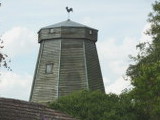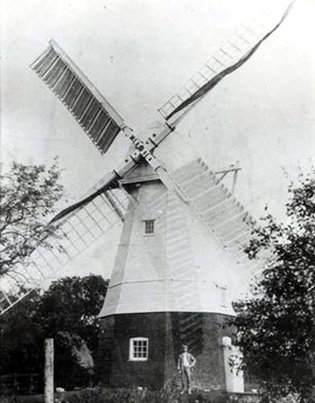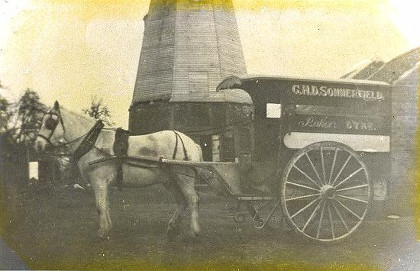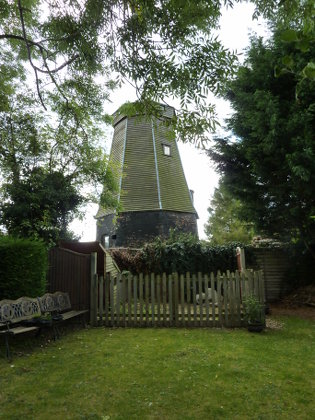The Windmill in Dyke
The windmill located in Dyke is one of scores built in the area called the Lincolnshire Fens.The design constructed with a stone or brick base upon which was built a timber upper structure is known as a “smock mill” and the one in Dyke is the last to exist in Lincolnshire.
Early history of Dyke Windmill
 Windmills were first used in the Lincolnshire Fens during the 17th century. This was a time when the first really successful attempts were being made to cultivate and seriously farm the area.
Windmills were first used in the Lincolnshire Fens during the 17th century. This was a time when the first really successful attempts were being made to cultivate and seriously farm the area.
.
Windmills were first used in the Lincolnshire Fens during the 17th century. This was a time when the first really successful attempts were being made to cultivate and seriously farm the area.
Originally built around 1650 the mill was first used for powering water pumps in nearby Deeping Fen. The exact date of building and location are not known. The design with a stone or brick base and timber upper structure is known as a “smock mill” and this one is the last that exists in Lincolnshire. As developments took place a form of power that relied less upon the weather was needed and for this reason steam power slowly took over making wind powered mills redundant. Around 1840 the mill was dismantled in Deeping and transported to Dyke where it was rebuilt. Once erected on its present site it started work as a corn mill for which it was fitted with three pairs of stones. Two of the pairs of stones were used for producing flour for domestic use and one pair for grinding cattle food. A flour dressing machine was added in which the wholemeal flour ground was dressed by passing it through a silk screen to produce white flour.
Dyke mill in 1905. Reproduced from “A Portrait of Bourne.” © Rex Needle 2015.
Life in Dyke at the time
In 1875 the mill came up for auction along with a newly-built house nearby. The highest bid received was £490 by Mr Joshua Walpole of Dyke, however, there was a reserve of £600 resulting in the lot not being sold. At some later date negotiations took place resulting in Mr Walpole buying the mill. In 1876 John Thomas Summerfield of Hanthorpe bought the mill and it remained in the family as a going concern until 1927. In the 1890’s the mill was completely renovated with four new sails fitted and the supporting tower structure re-boarded and made weatherproof. At about this time one of the pairs of wheat grinding stones was removed and replaced by a second pair of stones for grinding cattle feed.
Mr George Sommerfield’s cart and horse Bob in front of Dyke mill 1925.
Reproduced from “A Portrait of Bourne.” © Rex Needle 2015.
The mill continued working until 1926 when one of the sails broke off halting the production of flour. Upon consideration it was deemed not an economical proposition to replace the broken sail meaning its life as a working mill came to an end. The next year saw the machinery removed and sold resulting in the mill laying dormant.
“Dyke Mill being dismantled by Mr Tom Sommerfield in 1926”
Reproduced from “A Portrait of Bourne.” © Rex Needle 2015
The Mill today
After 1927 when the flour grinding equipment and machinery had been removed and sold, the mill finally fell silent. Like all buildings and structures that have initially been built to do a job of work, the noise they create becomes a part of the scene and once silent the character changes. Today the mill structure stands silent and aloof in a small enclosure of its own. The last miller to work the mill was Mr Thomas M. Sommerfield and he had taken considerable care and pride in it as his father before him. The mill is now owned privately and in the early 2000’s restoration work was carried out. Rotten and damaged timber was replaced with appropriate new material retaining the looks of the working mill in former days.
Dyke Windmill as it exists today.
In researching this page reference was made to the following:
A Portrait of Bourne by Rex Needle
Dyke Womens’s Institute: Village Scrapbook for Dyke, 1965
Welcome to Spalding: A web site providing information on Spalding and surrounding area.
More About:
Dyke WI
The Windmill in Dyke
Dyke Baptist Chapel
Dyke Village Green
Dyke Village Hall
Dyke Engine House
The Railway in Dyke
The Wishing Well Inn
The Car Dyke
Dyke Village Life
Contact Dyke Village Hall
Main Road, Dyke, Bourne, PE10 0AF
Email: contact@dykevillagehall.org.uk




